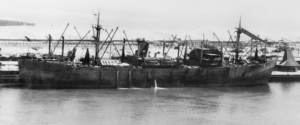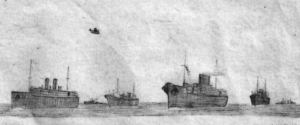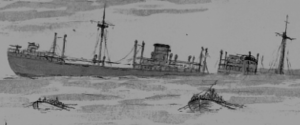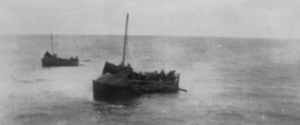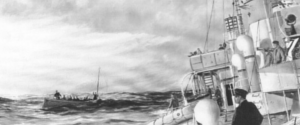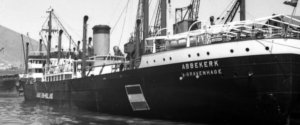25 ships leave Tjilatjap, only 12 will reach their destination

They were still at it (loading men) when dawn broke. At intervals all during the night, new groups of men appeared upon the dock to take their places in the boarding line (..) The Abbekerk had become a crowded ship.
‘They fought with what they had’ by Walter D. Edmonds
Next to Abbekerk, Kota Gede’s decks are also crowded with troops and refugees.
(Source: http://nimh-beeldbank.defensie.nl)During the day the men kept coming aboard. A more diverse lot I have never seen. Aircraft crews still wearing their thick woollen jackets, a few high and a lot more lower officers, soldiers and sailors, both with and without weapons, and then some civilians, many with worried and tired faces. Well what can you expect? Most had left family behind and all faced a dangerous and uncertain future. They were spread over the entire length of the ship as well as in the top holds. For most it was not easy. They had to leave, unprepared and hastily, very familiar surroundings and were literally plonked into the hold of a freighter, not a particularly well placed area to escape from in case of an emergency.
Adriaan Kik, ass. engineer on Abbekerk
The evacuees are -rightly off course – not impressed by Abbekerks almost non existing AA defences and even less by her few lifeboats and rafts. Extra bundles of bamboo and empty oildrums were loaded on deck to float free in case the ship was sunk.
And according to the grapevine, always gospel to credulous, she carried a big load of bombs in her holds. The men realized that once the Abbekerk put to sea, the lives of all aboard her would hang upon the cast of fate. As one pilot said: “If she was sunk, you drowned. There was no question of anything else.”
‘They fought with what they had’ by Walter D. Edmonds
Then comes news: USS Langley, with 36 fighter planes aboard, is sunk by Japanese aircraft only 70 miles south of Tjilatjap. The Seawitch would eventually arrive but her crated planes will never be assembled. Meanwhile The Eastern Strike Force, consisting of almost all the warships the allies have left here, is desperately searching for the Japanese invasion fleet north of Java. Mid afternoon they make make contact with the Japanese warships protecting the fleet and start a battle that would last for more then 10 hours and would become known as the Battle of the Java Sea.
In the mean time the the merchant ships at Tjilatjap which have sufficient range get their orders to leave. 25 Ships, most packed with refugees, prepare for a voyage to Fremantle Australia or Colombo Sri Lanka. Only 12 will reach their destination.
About three-thirty in the afternoon several tug boats came along and pulled Abbekerk out into the harbor. The R.A.F. boat that was alongside us had gone ahead of us, where it anchored and then waited for several other boats to join it and make up a convoy. R.A.F., American and Dutch Catalinas (flying boats) were continuously taking off. They were ferrying evacuees to Australia. We commenced to slide down the river and as we did the Australian ack ack battalions on the shore waved us goodbye. These were them men who stayed behind to fight. To be killed or to become guerrillas.
Flight surgeon Captain James E. Crane, Far East Air Force
For all her lamentable appearance his ship (Abbekerk) was capable of making 18 knots or better and he (her master) had no intention of holding her down to the slow pace of a convoy. As twighlight deepend, he turned off suddenly on a seperate course, almost due south, for Australia.
‘They fought with what they had’ by Walter D. Edmonds
In fact Abbekerk was never ordered to form convoy: her speed is a better defence than any convoy (without escort) can provide. The larger ships simply had to wait till high tide to negotiate the shallow entrance so they were the last to leave. But now with high tide, one after the other take to sea.
And so we went at a snail’s pace. On that same day a total of 25 big and small ships amongst which were the ‘Zaandam’ and the ‘Jagersfontein’ departed from the Tjilatjap harbour with the knowledge that the sea between them and their destination was infiltrated with Japanese warships, aircraft carriers and many submarines. The Captains had to decide their own course to steer and in the engineroom the engines were stretched to the limit. None of the passengers knew that in the bottom hold there were a couple of thousand tons of ammunition. I believe that every member of the crew found it better not to speak about it and as far as I know we did not speak about the unbelievable number of S.O.S signals we started to received from ships (merchant and navy) sailing in our vicinity. All were about attacks from planes, surface ships and submarines. We asked ourselves: ‘Will this mess never end?’
Adriaan Kik, ass. engineer on Abbekerk
List of ships leaving Tjilatjap February 27th, names in bold were sunk or taken by the Japanse:
- Jagersfontein (10.083 brt)
- Abbekerk (7900 brt)
- Poelau Bras (9278 brt)
- Tawali (8200 brt)
- Enggano (5412 brt)
- Siantar (8667 brt)
-

The ms Modjokerto is one of the 12 ships leaving Tjilatjap on the 27th that would never arrive. Her faith was only discovered in 1946.
(source: maritiemdigitaal.nl)Modjokerto (8806 brt)
- Kota Gede (7227 brt)
- Zaandam (10.909 brt)
- City of Manchester (8917 brt)
- Zuiderkruis (2661 brt)
- Pecos(5723 brt)
- Merkus (865 brt)
- Sigli (1579 brt)
- Generaal van Geen (1268 brt)
- Toba (983 brt)
- Tosari (981 brt)
- Tinombo (872 brt)
- Bandjermasin (1279)
- Parigi (1172 brt)
- Tohomon (983 brt)
- Toradja (981 brt)
- Sibigo (1594 brt)
- Le Maire (3271)
- Bintoehan (1021)
Merchant shipping losses in the area: 27 February 1942 Moesie (Dutch) The coaster was torpedoed and sunk 25 nautical miles (46 km) off Banjoewangi, Dutch East Indies by I-53

